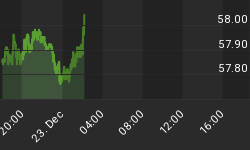We are confident of the reliability of our research. A similar approach used in the summer of 1998 merited the same title and, while it applied to global banks, Citigroup, as an example, plunged 60% from $29.58 that fateful July to $11.58 on October 8.
1998
In the first page of charts, the BKX index is used and key to the topping process was the spike and failure of our proprietary Bank Trading Guide in late April, 1998 (bottom clip). This provided the alert to a potential reversal.
Marked as (1), it was accompanied by a momentum high as measured by the RSI, also marked (1).
Then 13 weeks later, momentum surged to a lower peak (2), which was a few days earlier than the secondary peak on the Guide, also marked (2).
Both indicators provided negative divergence against the higher high for the BKX set on July 17, 1998.
Amidst discoveries of reckless trading by LTCM, the hedge-fund giant, bank stocks around the world were hit and the 42% crash in the BKX provides the overall measure.
Of significance is that the two key highs on the index, as well as on the indicators, were 13 weeks apart and that the crash was accomplished in 12 weeks.
Note how the RSI anticipated the bottom in early October. The Bank Trading Guide leads at significant tops and is roughly coincidental at important bottoms.
WIDOWS AND ORPHANS SELL : 1998
Vertical bars emphasize the 13 weeks from primary to secondary high.
2006
PRIMARY HIGH
This time around, the Bank Trading Guide gave the alert signal in early May, which was accompanied by the high in the RSI and the primary high for JP Morgan. JPM is used rather than the BKX because Citigroup's poor performance recently is constraining momentum on the banking index.
These distinctive points were coordinated and, after some consolidation, the market has rebounded.
SECONDARY HIGH
The interval from the primary peak to the possible secondary has been 13 weeks.
Also noteworthy is the negative divergence provided by the lower highs for the RSI and the Bank Trading Guide.
COMPLETING EVENT
At the secondary high in 1998, a senior bank stock ended the rally with an outside reversal to the downside (elaborated following the next chart).
WIDOWS AND ORPHANS SELL : 2006
Once the secondary high is complete, the low should be 12 weeks later.
Within the concluding pattern, there is a brief but possibly important trading event.
On Tuesday, the trading range for JPM set a higher high than the previous day, a lower low, and a lower close which, in the jargon, is called an outside reversal to the downside. This occurred again today.
It is a feature of volatility often seen at important tops as its opposite is seen at significant lows. As an example, the latter occurred with the recent low for treasury bond prices.
However, in looking at the topping pattern for banks in 1998, Citigroup set its high of 29.58 on July 21, which also did the "outside reversal" which initiated that crash. It didn't show up in the BKX index.
So, at the critical tops in 1998 and now, a senior bank stock concluded the 13 week interval from the primary to the secondary peak.
Our Bank Trading Guide was developed in early 1997, when its first usage in real time resulted in a brief 16% slump.
This is the third test in real time and the big pattern set in 1998 has been replicated with remarkable fidelity. Thus the confidence in our sell recommendation.
Of course, the reason for a significant slump, as in 1998, need not be known ahead of time but, as in any binge of aggressive banking, the mistakes are made on the way up and, inevitably, are revealed on the way down.
This study uses a U.S. bank index (BKX) and one stock (JPM) to represent the model. Derived conclusions can be applied to most players in the global banking business ranging from money centre banks to sub-prime lenders.
There is no guarantee that the market will continue to follow the pattern, but then there is no guarantee that it won't.
















